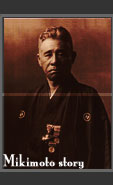| |
The biggest name in South
Sea pearls is that of the Paspaley family, which controls the major part
of South Sea pearl production from its base in Broome, Australia. The
story of how the Paspaley Pearling Company was set up is a very interesting
one. Like the other two big names in pearls, Mikimoto and Robert Wan,
the Paspaley fortune was a self-made one.
The
commercial development of pearl cultivation in Australia is said to have
been started by one Con Denis George, a Greek immigrant from Constantinople,
who first experimented with the cultivation of pearls in Cairns, North
Queensland. However, it was perfected by another Greek immigrant from
Kastelorizo, Nicholas Paspaley, in Darwin and the north of Australia in
the 1960's. Actually, fishing for pearl oysters is said to have begun
in the 1850's in the shark infested waters of Western Australia, but then
the divers moved further north. Initially, the diving took place in shallow
waters but later the pearl divers began venturing into deeper waters as
well. In the beginning, the divers did not know the value of the pearl
and were more interested in the mother of pearl on the inside shell of
the oyster.
|
|
| |
Slowly
a number of towns on the coast came to be associated with pearling
and in 1870, the town of Cossack grew to be the centre of the pearling
in Western Australia. But like all natural resources, pearls grounds
too get exhausted and when that happened, Cossack was abandoned
completely and the pearlers moved further north. The new pearling
centre was now established at Port Hedland and it was here that
the Paspaley story began.
|
|
|
|
In
1919, a tobacco merchant by the name of Theodosis Paspalis arrived
with his family in Port Hedland. Here he established a grocery store
and bought a share in a pearl lugger (the vessels used for pearl
fishing). However, Theodosis died after only five years and it was
left to his children, Michael, Nikolas, and Mary to carry on his
dream. At the same time, there were quite a few Greeks involved
in the pearling industry in the region, mainly in Port Hedland,
Broome, and the North Western part of Western Australia. Michael
Paspalis worked in Port Hedland for a number of years, acquiring
a few pearl luggers. He was reputed to be a very good pearler and
sailor and this reputation received a real boost when he proved
to be the only pearler to rescue his entire fleet from a cyclone
that wrecked almost all the other pearl luggers in Port Headland
in the 1920's.
There
are other legends about Michael Paspaley. One says that he found
the pearl of his dreams thanks to a dream that he had. He is said
to have dreamt that he would find a most beautiful pearl the next
day. Accordingly, the next morning, he sat on the lugger deck and
told his crew that he would be the only one to open all the oysters.
He ordered his entire crew away from where he sat opening one oyster
after the other and sure enough, he found a magnificent pearl inside.
He hid the pearl in his pocket and without betraying his joy, he
told his crew that he did not find anything. Pretending that he
needed to go to Port Hedland to bring supplies, he left the lugger,
taking the pearl with him. There he is said to have sold the pearl
for the princely sum of 400 pounds, which was indeed a lot of money
in those days. |
After
some time, pearling in Port Hedland ceased to be as profitable as
it had once been. The Paspalis siblings realised that the pearl
fields were slowly being exhausted and that it would be better to
leave before push came to shove and all the pearlers would begin
searching for fresher pastures. They therefore moved further north
to Broome where they established their business. |
|
|
In
1925, Broome was one of the important centres of mother of pearl
production and there were around 400 luggers supplying around 80%
of the world's mother of pearl. But then came the depression followed
by World War II. It was Japan's entry into the war that slammed
the last nail in the coffin of the Australian pearl industry. In
Broome alone, around 500 Japanese pearl divers were arrested and
interned for the duration of the war. Pearl luggers were dragged
in from the coast and burned for fear that they would fall into
enemy hands. Alternately some pearl luggers were sailed down to
Perth for safety.
Nicholas Paspalis changed his name to Paspaley and persisted in
Port Hedland until World War II, when the civilians were evacuated
from the area. After the war, he bought four luggers, which had
been abandoned by the Australian navy in Darwin and became the first
man to resume pearling from Darwin. However, in the 1950's the pearl
markets collapsed. It is said that when the times get tough, the
tough get going and Nicholas Paspaley did just that, he turned his
attention to pearl culture.
|
|
Left to right : The
warm nutrient rich waters of South Pacific are prefect for growing
the large South Sea Pearls.
Harvesting the Oysters.
|
By 1956, he established a partnership with a Japanese
businessman and set up a cultured pearl farm in Kuri Bay, 420 kms
north of Broome. It was the largest cultured pearl farm in the world.
In 1963, the Paspaley Pearling Company was set up together with
the Arafura Pearling Company (another Japanese company) and commenced
cultured pearl farming in Port Essington, east of Darwin. By the
1980's, the production had grown so much that the Kuri Bay farm
used 200,000 shells per year in its production, a Queensland operation
used around 70,000 and the Paspaley Pearling Company farm at Port
Essington used 70,000 shells per year. Its operation in Indonesia
was using 100,000 shells per annum, the one in Myanmar around 40,000
and the one in Malaysia around 30,000 shells per year. By now, these
numbers have multiplied.
Nicholas
Paspaley was in his late 60's when he passed away in 1984, but the
South Sea pearl empire that he left behind has immortalised his
name forever among the international pearl trade.
|
|
|
|
|





















